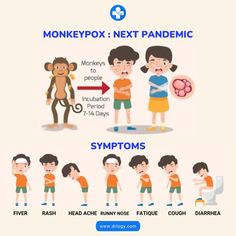MONKEY POX
MONKEY POX
Monkeypox is a viral zoonotic disease, meaning it can spread from animals to humans. It is caused by the monkeypox virus, which belongs to the same family of viruses as the variola virus, the virus that causes smallpox. While monkeypox symptoms are similar to smallpox, they are generally milder, and monkeypox is less contagious.
1. Causes and Transmission
- Virus: Monkeypox is caused by the monkeypox virus, a member of the Orthopoxvirus genus in the Poxviridae family.
- Transmission:
- Animal-to-Human: The virus is transmitted to humans through direct contact with blood, bodily fluids, or skin lesions of infected animals. In Africa, cases have been documented through handling monkeys, Gambian giant rats, and squirrels.
- Human-to-Human: Transmission occurs through respiratory droplets during prolonged face-to-face contact, direct contact with bodily fluids, or contact with contaminated materials such as bedding or clothing.
2. Symptoms of Monkeypox
Incubation Period: Usually 6-13 days, but can range from 5-21 days.
Prodromal Symptoms:
- Fever
- Intense headache
- Muscle aches (myalgia)
- Back pain
- Swollen lymph nodes (lymphadenopathy)
- Chills and exhaustion
Rash:
- The rash usually begins within 1-3 days of the onset of fever, starting on the face and spreading to other parts of the body.
- The rash goes through several stages: macules, papules, vesicles, pustules, and finally crusts that dry up and fall off.
3. Diagnosis
- Clinical Evaluation: Based on the characteristic symptoms, especially the rash, and history of possible exposure.
- Laboratory Tests:
- Polymerase Chain Reaction (PCR) tests to detect viral DNA.
- Viral culture, serological testing, and electron microscopy in some cases.
4. Treatment
- Supportive Care: There is no specific treatment for monkeypox. Treatment is generally supportive and aims to alleviate symptoms, prevent complications, and manage severe cases.
- Hydration: Ensure adequate fluid intake to prevent dehydration.
- Pain Management: Use analgesics and antipyretics to manage fever and pain.
- Skin Care: Maintain good hygiene, and use antiseptics to prevent secondary infections in skin lesions.
- Antivirals:
- Tecovirimat: An antiviral medication approved for the treatment of smallpox, which may also be used to treat monkeypox under certain circumstances.
5. Prevention
- Vaccination:
- Smallpox Vaccine: The smallpox vaccine has shown to be about 85% effective in preventing monkeypox. In some countries, it is used for individuals at high risk of exposure.
- Avoiding Contact with Infected Animals: Especially in regions where monkeypox is endemic.
- Isolation of Infected Individuals: To prevent the spread of the virus to others.
- Use of Personal Protective Equipment (PPE): Healthcare workers and caregivers should use PPE when caring for patients with monkeypox.
6. Complications
- Secondary Infections: Bacterial infections of the skin lesions.
- Pneumonia: In some cases, viral pneumonia may develop.
- Sepsis, Encephalitis: Though rare, these can occur and are serious complications.
- Corneal Infection: Leading to vision loss in severe cases.
7. Epidemiology
- Geographic Distribution: Monkeypox is primarily found in Central and West African countries, with occasional outbreaks in other regions due to travel or animal importation.
- Outbreaks: While generally sporadic, monkeypox outbreaks have occurred, highlighting the importance of surveillance and prompt public health response.
8. Public Health Implications
- Surveillance: Enhanced monitoring and reporting of monkeypox cases are crucial for controlling outbreaks.
- Public Awareness: Educating the public about the signs, symptoms, and prevention of monkeypox is essential in endemic areas and during outbreaks.
- Research: Ongoing research into vaccines, antiviral treatments, and the epidemiology of monkeypox is necessary to improve control and prevention strategies.




.jpg)
Comments
Post a Comment